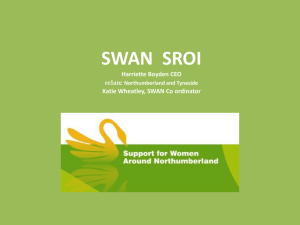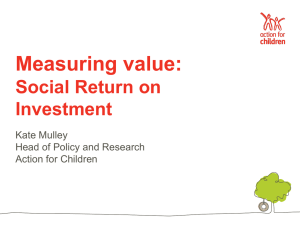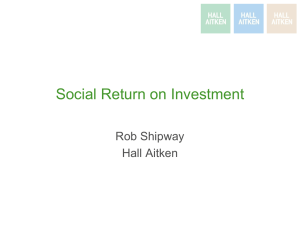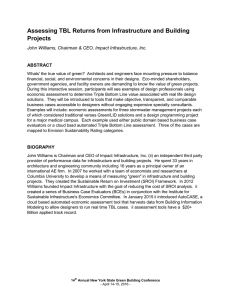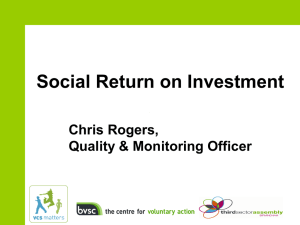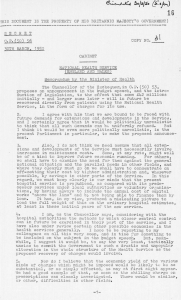Measuring social impact for Social Enterprises
advertisement
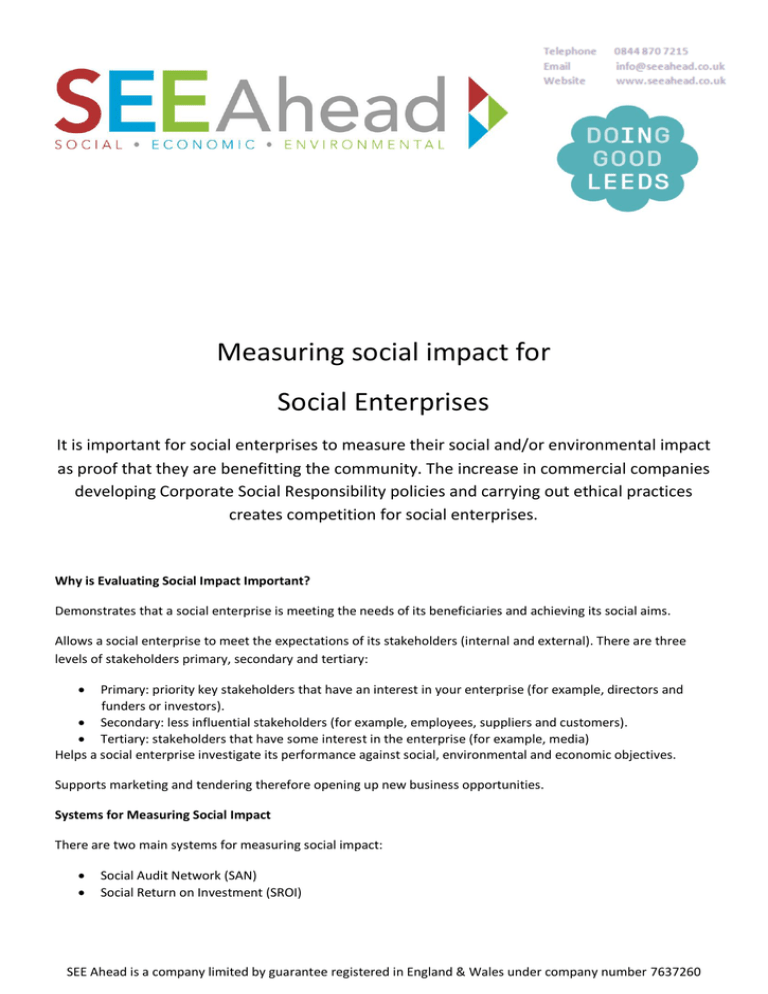
Measuring social impact for Social Enterprises It is important for social enterprises to measure their social and/or environmental impact as proof that they are benefitting the community. The increase in commercial companies developing Corporate Social Responsibility policies and carrying out ethical practices creates competition for social enterprises. Why is Evaluating Social Impact Important? Demonstrates that a social enterprise is meeting the needs of its beneficiaries and achieving its social aims. Allows a social enterprise to meet the expectations of its stakeholders (internal and external). There are three levels of stakeholders primary, secondary and tertiary: Primary: priority key stakeholders that have an interest in your enterprise (for example, directors and funders or investors). Secondary: less influential stakeholders (for example, employees, suppliers and customers). Tertiary: stakeholders that have some interest in the enterprise (for example, media) Helps a social enterprise investigate its performance against social, environmental and economic objectives. Supports marketing and tendering therefore opening up new business opportunities. Systems for Measuring Social Impact There are two main systems for measuring social impact: Social Audit Network (SAN) Social Return on Investment (SROI) SEE Ahead is a company limited by guarantee registered in England & Wales under company number 7637260 Social Accounting Process Flow The process for social accounting has four main stages. First phase: Social Enterprise: Identifying the social enterprise’s vision, mission and values Setting objectives and priorities to meet the vision Defining the long-term vision and what the social enterprise will achieve in the long-term Outlining the medium-term strategy and the key milestones Laying down the short-term operational criteria Second phase: External View: Assessment of stakeholders and services delivered Evaluation of benefits received by external stakeholders Identification of problems Design, planning and implementation of solutions Third phase: Internal View: Assessment of the organisation Evaluation of the effectiveness of operations Review of the efficiency of the management systems Appraisal of the board members, staff and volunteers’ satisfaction Fourth phase: Review and Planning: Learning lessons Making changes for improvements Planning the following year’s strategy and criteria A social audit is an external assessment of the above. Basic social accounting framework A social accounting framework can provide a basic system for measuring your social impact. It can be used as a foundation to build upon to meet the requirements of funders and potential contract providers. i) Mission This is your mission statement – a sentence that captures what the enterprise is about. ii) Values Use several words that you would like your beneficiaries and customers to value you by. iii) Objective Each objective should be one of your social aims iv) Activity List each activity that will be carried out to meet each objective SEE Ahead is a company limited by guarantee registered in England & Wales under company number 7637260 v) Quantitative monitoring method (outputs) List the ways that you will quantify the impact you have made. For example, how you will evidence and record the number of beneficiaries you support. For training social enterprises, how will you evidence and record the qualifications beneficiaries have obtained? vi) Qualitative monitoring method (outcomes) This is the recording of ‘soft outcomes’. List the ways you will evidence and record the impact you have had on individuals. For example, use feedback questionnaires or diaries for the individuals to complete. TIP – Using third party sources will substantiate the impact you have had on individuals. For example, school teachers, care and support workers. Using reports from other providers supporting the individuals will add to your evidence. It is important to ensure that you adhere to data protection legislation. There may be other providers, particularly those supporting vulnerable individuals, who cannot provide you with personal information. Long-term measurement of the impact you have on individuals is extremely valuable. Social Return on Investment (SROI) SROI measures service outcomes to compare the financial investment made against the benefits created for stakeholders (added value). A longer term assessment of the value of outcomes in terms of market values or values to government or other ‘proxies' and putting a sterling value on them. The term proxy is a substitute source of the value of the outcomes but must be a reliable source for example the EU. Impact map Stakeholders Inputs Outputs Outcomes Impacts Value of contract Description of service contracted to deliver Additional outcomes Proxy value of each additional outcome and calculation to support statement The outcomes are itemised with proxy values of each outcome and calculation to support the statement. The proxy values must be ascertained from credible sources including UK central government and / or EU. SEE Ahead is a company limited by guarantee registered in England & Wales under company number 7637260 Example: Fresh Pastures Input Output Outcome Impact Leeds contract value £800,000 p.a. Supply of milk Use of Euro 4 spec vehicles. Leading competitor uses both Euro 2 (E2)and Euro 3 (E3) spec vehicles according to report not due for replacement until 2010. Euro 5 due in 2010 CO2 limits same E4 and E5 based on 1500km per week per van – against milk coming from Newcastle and then distributed from Leeds. Value calculated for 4 E2 and 4 E3 vehicles on this contract and emissions “cost” calculated on this basis. £96,800 Recycling of Waste cartons Calculation based on the estimated contract usage figures for waste weight, and current costs of landfill tax and commercial bin emptying service by Leeds City Council £106,000 Access to Visitors Centre Calculation based on a standard child entrance fee for an attraction of this type at £5.00 per child £150,000 Employment and retraining for long term unemployed Difficulty in calculating a value to this as it has many variables and secondary implications. £100,000 in wages SEE Ahead is a company limited by guarantee registered in England & Wales under company number 7637260 back into local economy £21,000 reduction in benefits over 26 weeks Not including: Education resource, Elderly visitors programme, Healthy eating promotion, Road safety, Disability awareness TOTAL £473,000 SROI = £ 59p in every pound of contract value. The Social Return on Investment (SROI) is the impact value (£473,000) divided by the input (£800,000). This equates to 0.59. For every pound of the contract spent, there is a social return of 59p. SAN vs. SROI SAN SROI Advantages Advantages Effective way of monitoring performance Allows stakeholders to have a say Points out areas for improvement Disadvantages Time consuming Cost of Social Auditors Danger of manipulating stakeholder views Step by step and not timeconsuming to do Useful in marketing, selling and tendering Disadvantages Danger of using proxies to overstate values Difficult to find some proxies for ‘soft outcomes’ such as ‘quality of life’ outcomes SEE Ahead is a company limited by guarantee registered in England & Wales under company number 7637260 Remember... To be able to evidence the ‘added value’ when using SROI, processes of measuring social impact should already be implemented. Where to go for Further Help SEE Ahead www.seeahead.co.uk Social Audit Network (SAN) www.socialauditnetwork.org.uk SROI Network www.sroi-uk.org Selling Added Value www.sellingaddedvalue.co.uk SEE Ahead is a company limited by guarantee registered in England & Wales under company number 7637260 SEE Ahead is a company limited by guarantee registered in England & Wales under company number 7637260 SEE Ahead is a company limited by guarantee registered in England & Wales under company number 7637260
